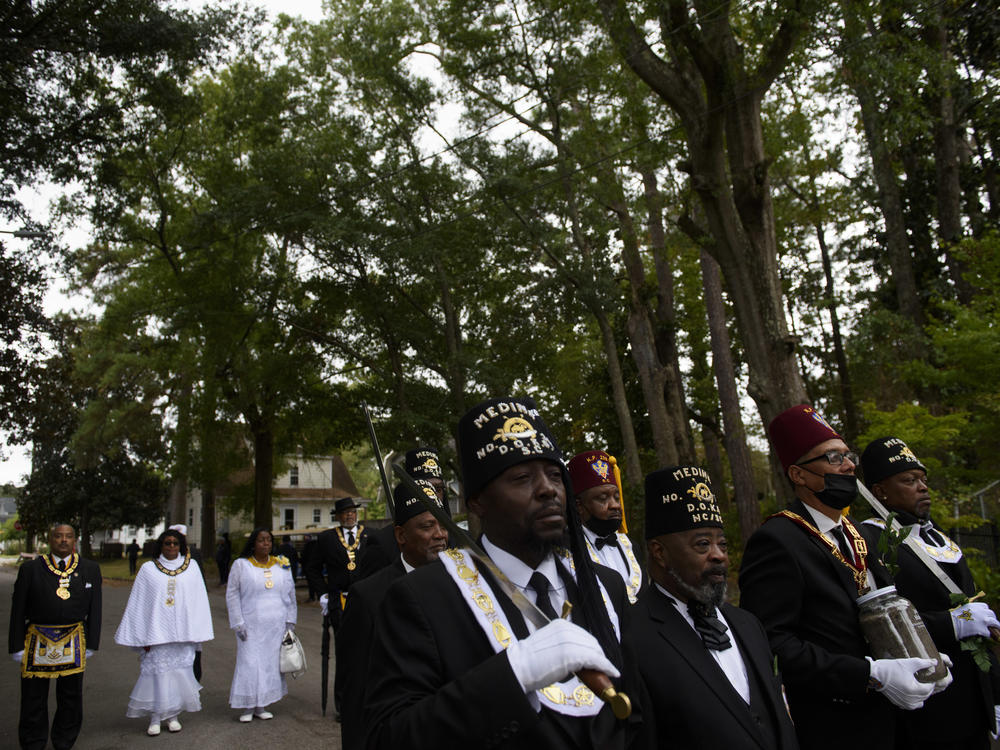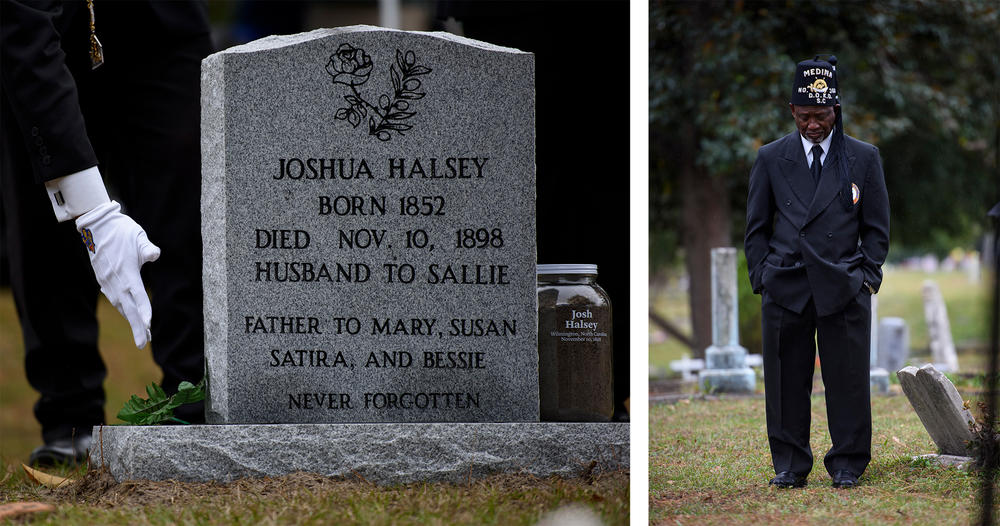Section Branding
Header Content
A North Carolina city begins to reckon with the massacre in its white supremacist past
Primary Content
On Nov. 10, 1898, a mob descended on the offices of The Daily Record, a Black-owned newspaper in Wilmington, N.C. The armed men then moved into the streets and opened fire as Black men fled for their lives.
Finally, the rabble seized control of the racially mixed city government. It expelled Black aldermen, installed unelected whites belonging to the then-segregationist Democratic Party and published a "White Declaration of Independence." Historians have called it a coup d'etat. The number of people who died ranges from about 60 to as many as 250, according to some estimates.
Reckoning with a haunted past
It's a past that had been largely forgotten or ignored by Wilmington's white population — and discussed only in hushed tones among the town's Blacks. In recent years, however, the city has embarked on a reckoning of sorts.
This week, Wilmington is marking 123 years since the massacre. In one event over the weekend, a procession and funeral were held at Wilmington's Pine Forest Cemetery to honor Joshua Halsey and Samuel McFarland, two of the few identified victims of the 1898 violence. Halsey's unmarked plot finally received a headstone.
In 2019, John Sullivan and his research partner, Joel Finsel, of the nonprofit Third Person Project, located the only known physical copies of the The Daily Record, which ceased publication after 1898. Then they set about searching for some of the victims of the massacre, finding Halsey's gravesite last year and McFarland's this year.
"You had a lot of bodies pushed into the river," Sullivan tells NPR. "You had bodies buried privately in backyards, sometimes days after the killings, because families were afraid to come forward and be associated with the victims."
He says others who hid in the swamps surrounding the city likely died of exposure or were lynched by the mob. The remains of the vast majority are unlikely to ever be found, according to Sullivan.
"Wilmington was the largest city in the state at that time," explains Kenneth Janken, a professor of African, African American, and diaspora studies at the University of North Carolina at Chapel Hill. "The majority of elected officials in the city government were African American."
Calls for lynching helped spark the massacre
Janken says that a white supremacist conspiracy to take over Wilmington was in the works for some months. It appeared to gain steam in the summer, when the owner of the The Daily Record, Alex Manly, wrote a rebuttal to a speech delivered by prominent Georgia writer, lecturer and white supremacist Rebecca Felton. She called for lynching African American men to "protect" white women. "I say lynch a thousand times a week if necessary," Felton proclaimed.
Manly's editorial, which accused whites of some of the same crimes they accused Blacks of, was picked up by white newspapers and circulated widely, Janken says. It proved incendiary.
"I'm not sure how much attention it got immediately, but it did catch somebody's attention," he says.
By the time of the election in early November, white supremacists had organized into "red shirt" squads that intimidated Black voters, leading to low voter turnout and ensuring a Democratic victory. Even so, because many aldermen were not up for reelection, the city remained in the hands of a governing coalition between Republicans and Populists.
That is until Nov. 10.
Prior to the violence, the city's population was just over half African American, with many of them prosperous business owners. But between those Blacks killed and the ones either driven out or forced to flee, the racial makeup of the city was forever altered. Elaine Cynthia Brown, who grew up in Brooklyn, N.Y., and now lives in California, is a great-granddaughter of Halsey. Sometime after the violence, his widow, Sallie, left Wilmington and never returned.
Brown says her family is spread across the U.S. as a direct result of what happened. "It changed our lives forever."
Finding the gravesites proved challenging
For Sullivan and Finsel, finding the remains was no easy task. On the centenary of the massacre, the city convened a commission to examine the history of the event. It produced a report in 2006 that mentioned two graves of victims believed to be in private plots at Pine Forest, but said they could not be found.
"The cemetery record-keeping was chaotic," Sullivan says. Over the years, things were moved, he says, "and there's a swamp right by the cemetery that floods occasionally, so things get wiped away."
The cemetery's handwritten registry was a major obstacle. During the COVID-19 pandemic, Finsel was allowed only short visits to the library. "He went back like 50 times, but he finally got the whole 900-page registry digitized, and then we started going to work transcribing it," says Sullivan.
Finsel likens the state of the archive to the Dead Sea Scrolls. "They were in tatters," he says.
The maps of the cemetery were like "fun house mirrors," Sullivan says. "There were five different systems used over the 170 years ... to locate information like how to categorize locations of graves."
Then Sullivan and Finsel got a key clue that helped them to triangulate Halsey's plot. The Pine Forest groundskeeper was able to locate the grave of Halsey's brother, who remained in Wilmington and died 23 years after the 1898 massacre. Joshua Halsey was buried nearby.
"We knew that they had been looking," Brown says. "Then John [Sullivan] called us and invited us to a Zoom meeting."
"We were just like, 'Oh my God,' " she says. "We all knew, as far as the family goes, what it meant."
Sullivan says he is just happy to make a contribution and document history in some small way. He thinks there could be others found buried at small cemeteries elsewhere in the city. For many of the victims, however, even if remains are found, "you'd have to get lucky with DNA."
As for McFarland, work is still underway to examine his headstone, which has deteriorated with age, according to Sullivan.
"I feel like our attempt to honor those killed is always going to have this cloud of scores of unknown dead hanging over it," he says. "The trick is to remember them whenever we're commemorating individual aspects of the massacre."
Copyright 2021 NPR. To see more, visit https://www.npr.org.
Bottom Content


